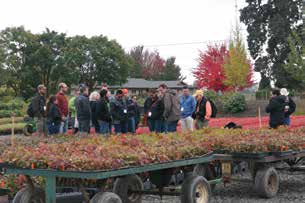THE NOBLE MAGNOLIA
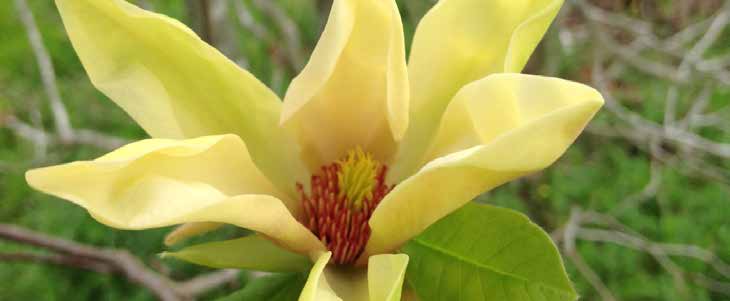
When I hear Magnolia, many different things come to mind. I think of Chip and Joanna Gaines with Magnolia Farms, the Grateful Dead song “Sugar Magnolia”, Julia Roberts in Steel Magnolias and, of course, the distinctive large, showy blossoms in white, pink, red, purple, or yellow on a Magnolia tree. Not growing up in the South, I always wondered why this particular plant was featured in the title of so many different things. That is, until I got to personally see, feel and smell one on my own. From the bright green, glossy leaves to their blossoms that are made up of enormous waxy petals, to that strong sweet perfume; the Magnolia quickly became a tree I would not forget.
Magnolias have been around for millions of years. Fossils dating back 100 million years demonstrate this tree is a survivor that has sustained numerous climate conditions over those years. No wonder this tree can grow fine naturally all around the world. Magnolia trees were first pollinated by beetles, they date back even before bees. It is thought those years of beetle pollination made the Magnolia blooms and leaves tough, increasing resistance to insect damage.
The state flower for both Mississippi and Louisiana, Magnolias are resilient, fragrant trees with elegant beauty. Their blooms release a sweet floral, lemony scent that drifts through the heat in southern towns. As stated by Southern Living Magazine, “When the sweet fragrance of Magnolia fills the air, you know you’re in the South.”
Including both evergreen and deciduous varieties, there are over 100 different species of Magnolias. Other than the typical difference, the deciduous trees lose their leaves in the winter months, while evergreen trees retain theirs. Choosing which variety to put in your yard can depend on factors like where you live, your choice of landscape, and the amount of time and care you want to invest in your Magnolia tree. Magnolias require very little care and are resistant to many diseases and pests. They can tolerate harsh Southern summers, and provide you with year-round beauty. Depending on where you live, Magnolias start blooming in early spring and set fruits and seeds in late summer and early fall, providing food for migrating birds.
With many varieties to choose from, we have selectively chosen to grow two varieties. Currently in production, we have Magnolia ‘Galaxy’ and Magnolia ‘Butterflies’.
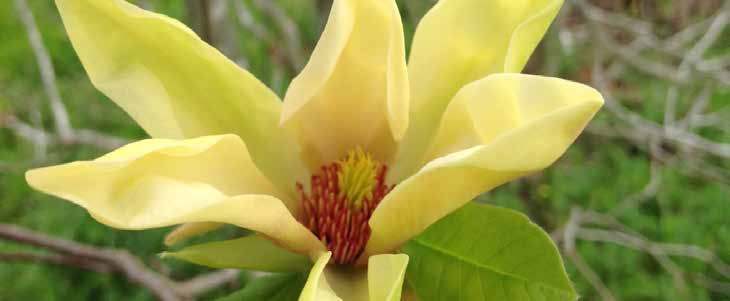
Magnolia x ‘Butterflies’ 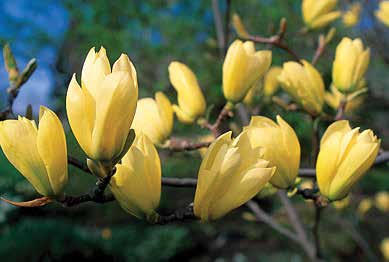
- Magnolia ‘Butterflies’, known as one of the earliest and finest yellow-flowered Magnolias, is an upright, pyramidal deciduous tree of breathtaking beauty while in full bloom. It’s tulip-shaped, rich canary yellow flowers, 6-12” across, appear in late April to early June. The upright blooms have a rich lemon fragrance and the flowers bloom profusely, smothering the branches. Thriving in both heat and cold, ‘Butterflies’ is sure to bring beauty and interest to your spring landscape, whether in your flower beds, as a border plant or grown as a flowering tree or hedge. Zones 5-9.
- A spectacular specimen plant for dramatic early spring blooms, Magnolia ‘Galaxy’ is sure to impress. This full sun to part shade lover, with a unique form and flower, is a small deciduous tree with a profusion of dark pink flowers in midspring. Opening from deep red-purple buds, the slightly fragrant, large flowers, 8-10” across, have a light pinkish-purple outside, and paler rose within. Galaxy is a single-trunked, upright tree with a narrow crown, growing to heights of 30-40’ with a spread of 20-25’. Winning many awards, Magnolia ‘Galaxy’ will be an excellent choice for a sunny area in the landscape where spring flowers can be appreciated. Zones 5-9.
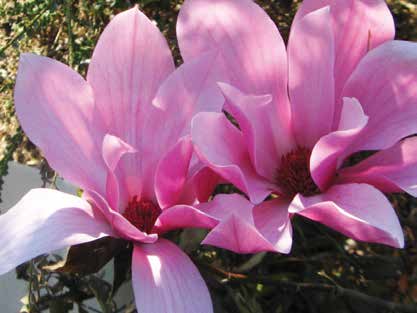
Magnolia ‘Galaxy’ 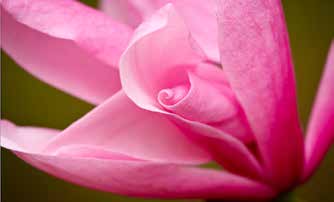
‘The Mantis’
“The Mantis” was built for efficiency in spraying and mowing by combining the two tasks into one unit and utilizing one employee to do the work that three were previously doing.
The machine was predominantly designed by Ruppert Nursery employees Ronnie Wright, full-time company mechanic, and Nick Graves, Farm Operations Manager, and a focus group of other employees. It took a number of prototypes to get to this point.
In May of 2015, Ronnie built the current version in Ruppert’s shop. It took him about three days to build, weld, assemble and work out the initial kinks.
The unit is made up of a 4120 30 HP John Deere tractor, Woods D80 Bush hog and a pull behind 200 gallon elliptical shaped tank. Two tee jet spray heads are mounted under each Enviromist dome, which are then mounted to the front of the tractor.
There are four toggle switches mounted to the right of the steering wheel. Each dome has a shut off switch and a control to raise the domes up and down separately. The domes can be raised up, tucked in tight to the machine and lowered down parallel to the ground when ready to use. The stock arms that come with the Enviromist dome sprayer are used and the spray heads are modified to put out more volume while using the dome height adjustment system that comes stock with the Enviromist system.
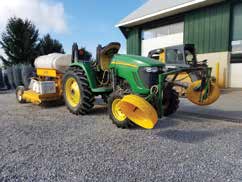
The sprays used are Glyphosate products with a low surfactant, Gallery/Prodiamine mix, Marengo, and Sureguard. The spray depends on the typesof plants, time of year and weeds that need to be controlled. The spray tipsare cleaned out and the bush hog is greased after 8 hours of use. The bladesare sharpened every week or so. They are able to treat about five acres or eight blocks of trees per day.
The farm is hilly so the “Mantis” is operated slowly to get proper coverage and the dome height is continually adjusted to avoid hitting any trees. Poor operation will lead to unwanted spraying of trunks, suckers and trees. The mower is a 6 1/2’ PTO powered implement with the tank mounted on top. Once the mower is engaged, the driver can focus not only on the mowing of rows but the proper banding of the intended herbicides. The grassed rows are 10’ wide and trees are spaced 7’ on center. This machine is not used in the shrub or evergreen blocks, with some exceptions.
Pros and Cons
Pros: It definitely helps save some time, but Ruppert is constantly tweaking for better performance. If something breaks more than once they take a hard look at it and try to make it better. This piece of equipment, although far from perfect, helps to exemplify innovative problem solving and keeps employees engaged in that type of thinking. Labor is harder to come by so innovation and equipment adaptation is increasingly important for the business.
Cons: The sprayer needs to be stopped for about 8 seconds at the end of each row to allow domes to stop dripping so they don’t kill good turf. The ground is often uneven and it only takes a second of not paying attention to damage or bend the frame of the sprayer. Repairs and downtime are costly.
The next version they build will have a bigger tank with less fill up time. It will require a higher horsepower tractor due to the extra weight. They will use lower profile domes and tuck them in closer to the tractor so it can slide it underneath evergreens and shrubs.
Bursting at the Seams Once Again
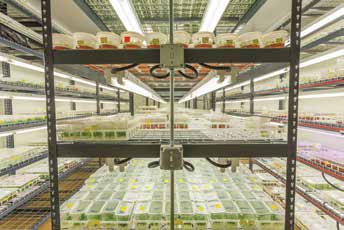
The Carlton Plants Tissue Culture effort began life in a very modest fashion, with recycled lab equipment purchased on eBay in a very small laboratory built in an unused lunchroom at the propagation facility. This 500 square foot facility served well for a starting point for our fledgling efforts, but the successes that followed led to the construction of a new 3500 square foot lab, which we moved into in 2015. Now, with over 100 items in culture and production approaching the million mark, space has once again become an issue. The lab was designed with this in mind, and the building space will allow us to quite easily expand to meet our needs.
The lab was built as a “building-in-a-building”, using refrigeration panels to form the very tight, well insulated laboratory within the outer pole building shell. The open area within the pole building to the north of the lab will be enclosed using the same building panels to form two new culture rooms. These will double available culture space, allowing us to increase production dramatically. Since 2017 saw production increase 35% in one year alone, it is easy to see the justification; indeed we’re already considering the next move when once again it is bursting at the seams in the not too distant future.
CARLTON PLANTS CONSERVATION LANDOWNER AWARD
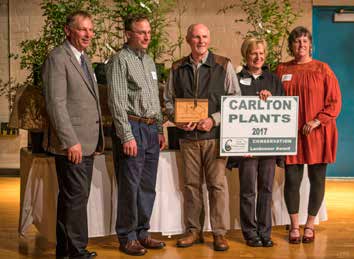
Larry Ojua, Jon Bartch, Allan Elliott, Catie Anderson, Barbara Boyer
Yamhill Soil & Water Conservation District awarded Carlton Plants the “George E. Otte Conservation Landowner Award” in October at the District’s 64th Annual Meeting. George Otte performed much of the original soil mapping in Yamhill County. The award has been given annually to landowners since 1966. Emphasis of this award is on long term conservation planning and practice implementation to protect soil, water and other natural resources. A special recognition was awarded to Allan Elliott for his “Leadership in Land Conservation” and long-term cooperation
with the Soil and Water District.
Western Region IPPS
On October 17th Carlton Plants hosted the Western Region of the International Plant Propagators’ Society (IPPS) for lunch and a tour of the propagation facilities. Over a hundred people attended from states across the nation as well as a few visitors from overseas. It was a cheerful occasion, with the tour receiving an enthusiastic response from visitor and host alike.
